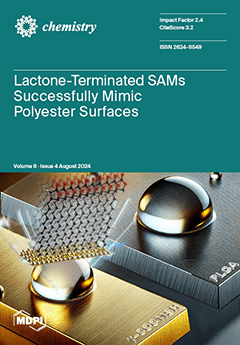Organometallic ruthenium complexes with
p-cymene = 1-methyl-4-(1-methylethyl)-benzene and N^N = bidentate polypyridyl ligands constitute interesting candidates with biological and catalytic properties. Towards this aim, we have synthesized four ruthenium(II)–arene complexes of the type [Ru(η
6-
p-cymene)(N^N)Cl][X] (N^N = Br-Qpy =
[...] Read more.
Organometallic ruthenium complexes with
p-cymene = 1-methyl-4-(1-methylethyl)-benzene and N^N = bidentate polypyridyl ligands constitute interesting candidates with biological and catalytic properties. Towards this aim, we have synthesized four ruthenium(II)–arene complexes of the type [Ru(η
6-
p-cymene)(N^N)Cl][X] (N^N = Br-Qpy = 6-bromo-4-phenyl-2-pyridin-2-yl-quinoline, X = Cl
− (
1a); PF
6− (
1b); N^N = OH-Ph-Qpy = 4-(4-phenyl-2-(pyridin-2-yl)quinolin-6-yl)phenol, X = Cl
− (
2a); PF
6− (
2b)). This is the first report of ruthenium(II)
p-cymene complexes incorporating substituted pyridine–quinoline ligands, with –Br and –C
6H
4OH groups in the 6-position of quinoline. We also refer to the cytotoxicity of the ligands and their possible effect of modulating the activity of the ruthenium(II) complexes. These were characterized by a combination of spectroscopic methods (ATR-IR, UV–Vis, multinuclear NMR), elemental analysis, and conductivity measurements. The solid-state structure of
2b, determined by single-crystal X-ray diffraction, reveals a three-legged piano-stool geometry. The in vitro cytotoxic activities of the new complexes were evaluated in HEK293T (human embryonic kidney cells) and in HeLa cells (cervical cancer cells), via the MTT assay. Poor in vitro anticancer activities were observed for the HeLa cancer cell line, with
2a being the most potent (IC
50 = 75 μΜ). The cytotoxicity of Br-Qpy in HEK293T is comparable to that of cisplatin. Both complexes
1a and
1b successfully catalyze the transfer hydrogenation of benzophenone to benzhydrol by 2-propanol at 82 °C. The catalytic performance of
1a in the ratio of S:Cat:B = 400:1:40 (S = substrate, Cat = catalyst, B = base = KO
iPr) leads to a conversion of 94%, within 3 h of reaction. Presumably, catalytic transformation takes place via ruthenium(II) hydride species being the active catalyst.
Full article





